Hello, my fellow product marketer! I'm Pedro Bojikian, and I'm super pumped to share my storytelling advice with you. I consider storytelling a big force in my career as a PMM. I love to take the stage to deliver product demos or talk about our product vision – always with a passion and curiosity for storytelling.
I’m going to share some thoughts on how I approach storytelling, but before we begin, I want to let you know that I based today’s case study on Shawn Achor’s TED Talk, ‘The happy secret to better work’.
If you haven't watched it yet, please do; you’ll get much more value out of this article. Plus, it's really funny.
My favorite storytelling books were also a huge inspiration for this article.
- Invisible Ink: A Practical Guide to Building Stories that Resonate by Brian McDonald
- Made to Stick: Why Some Ideas Survive and Others Die by Chip Heath and Dan Heath
- Pitch Anything by Oren Klaff
- The Catalyst: How to Change Anyone's Mind by Jonah Berger
- Making Numbers Count: The Art and Science of Communicating Numbers by Chip Heath and Karla Starr
- The Power of Myth by Joseph Campbell
I’ll only get into the first three today, but I highly recommend that you go and read them all.
A lot of people read these books, and a lot of people read articles like this one. However, reading is not enough. In my experience, the PMMs who excel at storytelling are the ones who keep these books close. They're constantly consulting them, rereading them, and applying what they learn every day.
It's a constant exercise. With time, you’ll find the frameworks you like the most for different situations until, eventually, you create your own framework that borrows a little from each. That's when the magic happens.
Let's get started.
Opening your narrative
We’re going to dissect the most important storytelling devices of this talk.
My first question to you is, what do you think is powerful about the way Shawn Achor opens this narrative?
When I was seven years old and my sister was just five years old, we were playing on top of a bunk bed.
When you start your narrative, it's like you have permission to put VR goggles on your audience. You need to invite them to embark on this adventure with you and share your worldview.
That’s exactly what Shawn does here. People are wired to listen to stories. It's how we survived as a species, sharing knowledge from generation to generation through stories told by the fire.
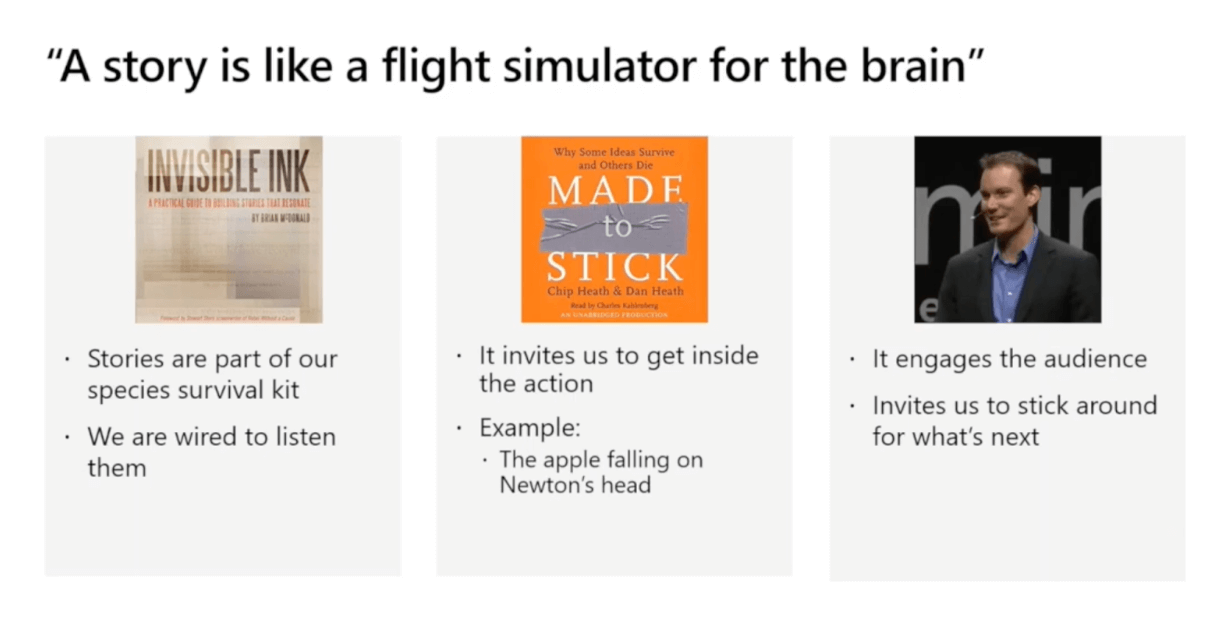
A good example of how stories help us to think about a subject is the legend of the apple falling on Isaac Newton's head. It paints a picture that invites us to learn more. That's why teachers around the world start with the apple story and not with “The particles attract each other with a force that is directly proportional to the product of their masses.”
Framing is key
If you take just one thing away from this article, make it the concept of framing. To win your audience, you need to control the narrative frame. People receiving your message have different narratives in their minds.
For example, the price might be top of mind for your audience, while you are interested in highlighting the superior quality of your product. From the beginning, you need to establish a worldview that will favor the point you want to make.
Chekov, the brilliant Russian writer, said that if you show a gun in the first act, you have to use it by the third act. The opening sets the path for your narrative to resonate with people. If you walk off that path, people are no longer going to be sure that they’re super excited about your story.
Let’s get back to Shawn’s story. At this point, according to his version of events, Amy has fallen off the bunk bed, without any help from her brother at all.
I saw my sister's face, this wail of pain and suffering and surprise threatening to erupt from her mouth and wake my parents from the long winter's nap for which they had settled.
So I did the only thing my frantic seven-year-old brain could think to do to avert this tragedy – and if you have children, you've seen this hundreds of times – I said, "Amy, wait. Don't cry. Did you see how you landed? No human lands on all fours like that. Amy, I think this means you're a unicorn."
Shawn does a very subtle but brilliant thing: he frames the story as being about human nature. This talk is about scientific research. It could be full of data and analytics, but he's not talking to a technical audience, so that wouldn’t land well.
Instead, when Shawn says, “If you have children, you've seen this hundreds of times,” he's inviting the audience to trust what they know to be true, rather than needing to be convinced by research data. That's very intentional, and he stays on this path over the course of his talk.
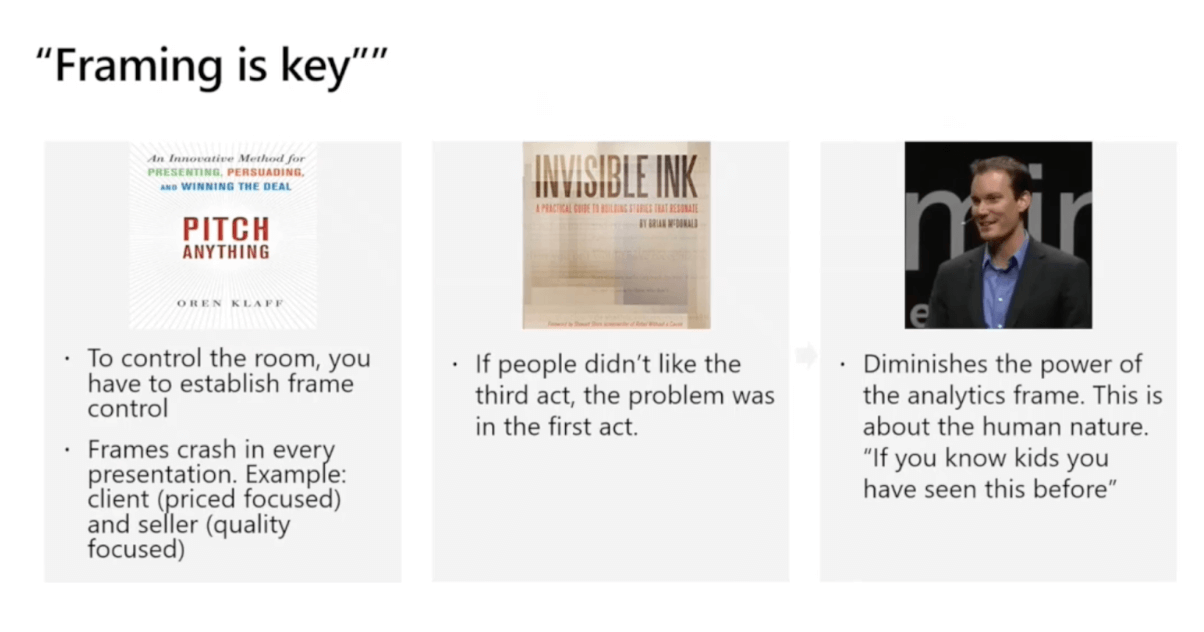
Making your case
Let's move into the second act of this narrative and see how Shawn makes his case.
When I started talking about this research outside of academia, with companies and schools, the very first thing they said to never do is to start your talk with a graph.
The very first thing I want to do is start my talk with a graph. This graph looks boring, but this graph is the reason I get excited and wake up every morning. And this graph doesn't even mean anything; it's fake data.
We all receive more messages than our brains can process, and our attention quickly wanders when we’re overloaded with information. Saying or doing something unexpected is a great tactic to win that attention back.
For example, most people tune out when they listen to the safety message on the plane, right? But if the flight attendant changes the script and says something like, “There are 50 ways to leave your lover but only three ways to leave this plane,” people will notice and they’re more likely to remember what the flight attendant says.
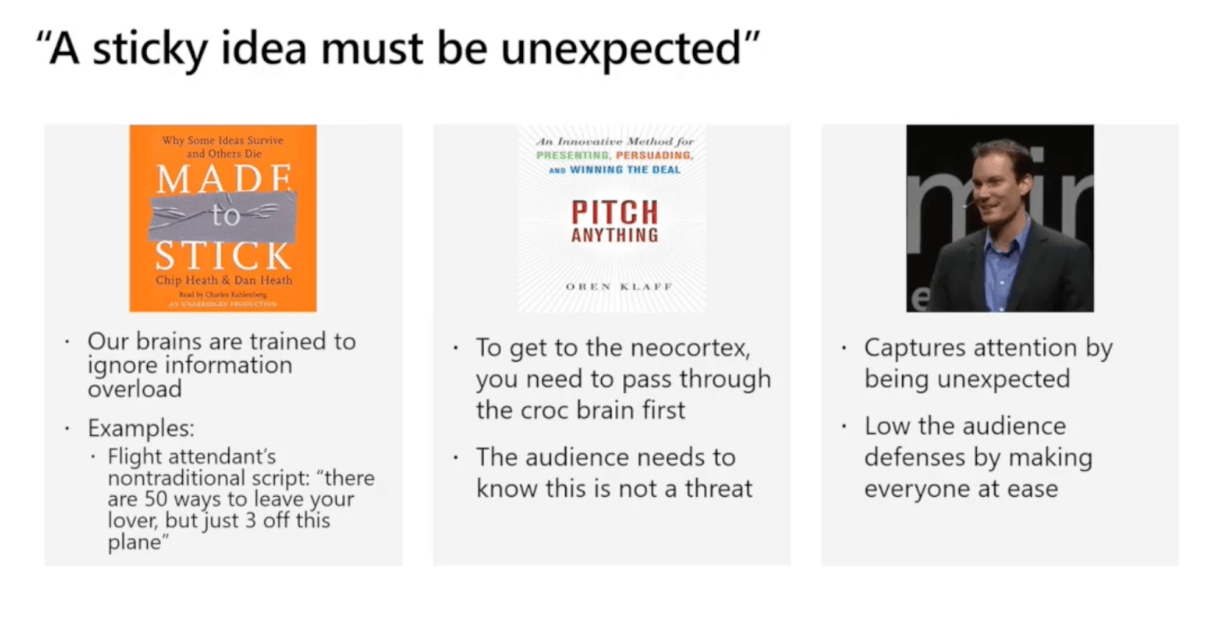
This is connected to how our brains work. If you want to get people to consider what you have to say, you need to get your message to the neocortex, which is the more rational part of the brain.
First, though, the message needs to go to the reptilian brain, the one responsible for fight-or-flight behavior. If something's unexpected, the reptilian brain may perceive it as a threat, which you of course want to avoid.
When you use humor, as Shawn did, you show your audience’s reptilian brains that you're not a threat, so they lower their defenses and open up to what you have to say.
And it's not only humor that works. There are a few different tactics you can use; you can show vulnerability, for example. What's important is that you put your audience at ease and show that you're not a threat.
A good story has armature
This is the second most important idea in this article: a good story has armature. I’ll show you what I mean with an example from our friend, Shawn.
During the first year of medical training, as you read through a list of all the symptoms and diseases, suddenly you realize you have all of them.
I have a brother-in-law named Bobo, which is a whole nother story. Bobo married Amy the unicorn. Bobo called me on the phone from Yale Medical School and Bobo said, “Shawn, I have leprosy,” which even at Yale is extraordinarily rare, but I had no idea how to console poor Bobo because he had just gotten over an entire week of menopause.
See, what we're finding is that it’s not necessarily reality that shapes us, but the lens through which your brain views the world that shapes your reality. If we can change the lens, not only can we change happiness, but we can change every single educational business outcome at the same time.
I’ll give you another example, this time from Steven Spielberg, one of my favorite storytellers.
In his movie Jaws, the main character is afraid of the water right from the beginning. The notion of conquering his internal fears is what connects the whole movie. The shark is really an external representation of his internal fears.
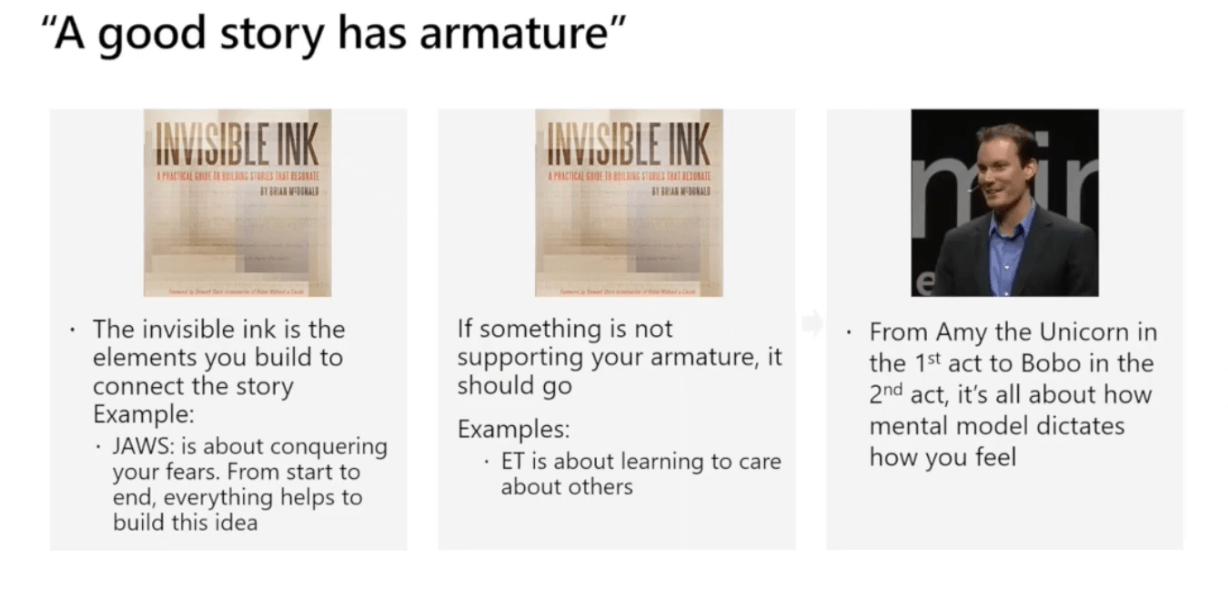
In Shawn’s TED Talk, all the anecdotes that he uses help to build the notion that it's not reality that shapes us; it's how we view the world that shapes our reality. It's both his main point and the connecting tissue throughout the presentation – that's a very good best practice.
A sticky idea must be simple
Let’s not forget the power of simplicity. As PMMs we often need to communicate complex technical details. The more skilful we are, the better we get at simplifying a message.
This applies to people from all walks of life. For example, a school principal could say, “The landscape around coronavirus continues to be uncertain, impacting the school district’s operations,” when all that people really need to hear is that schools are closed until fall.
In the TED Talk, Shawn does a great job of using terms that are easy to understand. He explains in plain language, that it’s not the world that shapes you; it’s you that shapes the world.
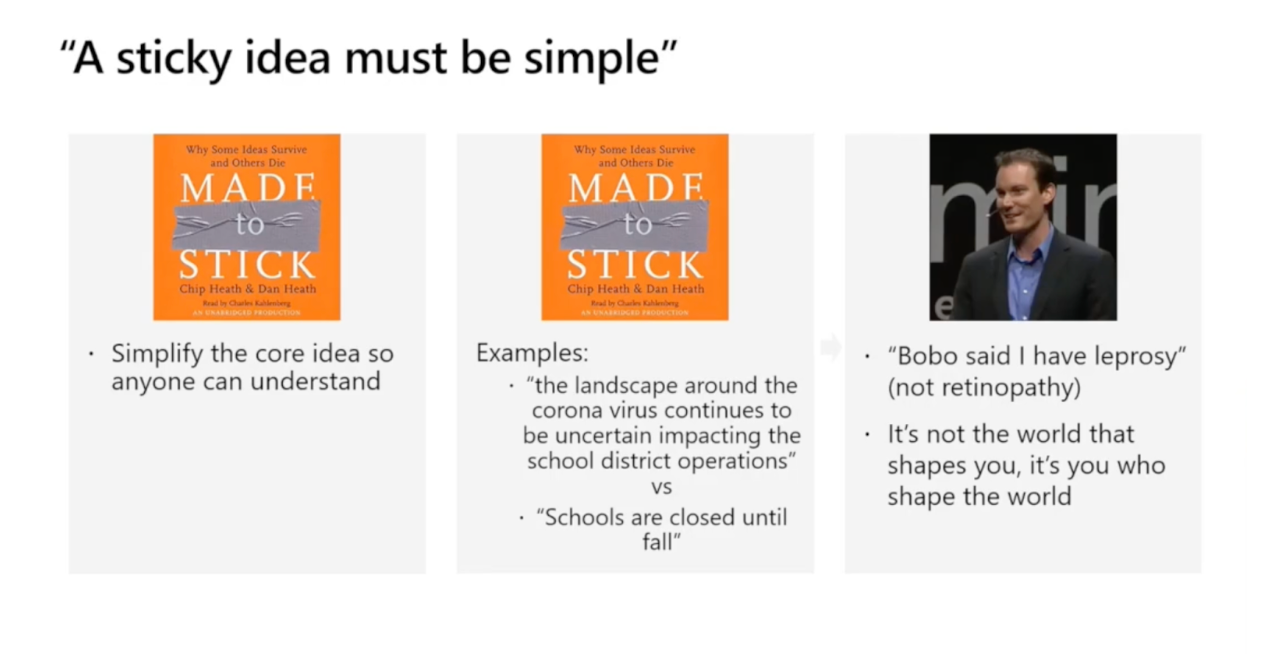
A sticky idea must be credible
Let's get back to Shawn:
What we found is that only 25% of job successes are predicted by IQ. 75% of job successes are predicted by your optimism levels, your social support, and your ability to see stress as a challenge instead of as a threat.
See what he did there?
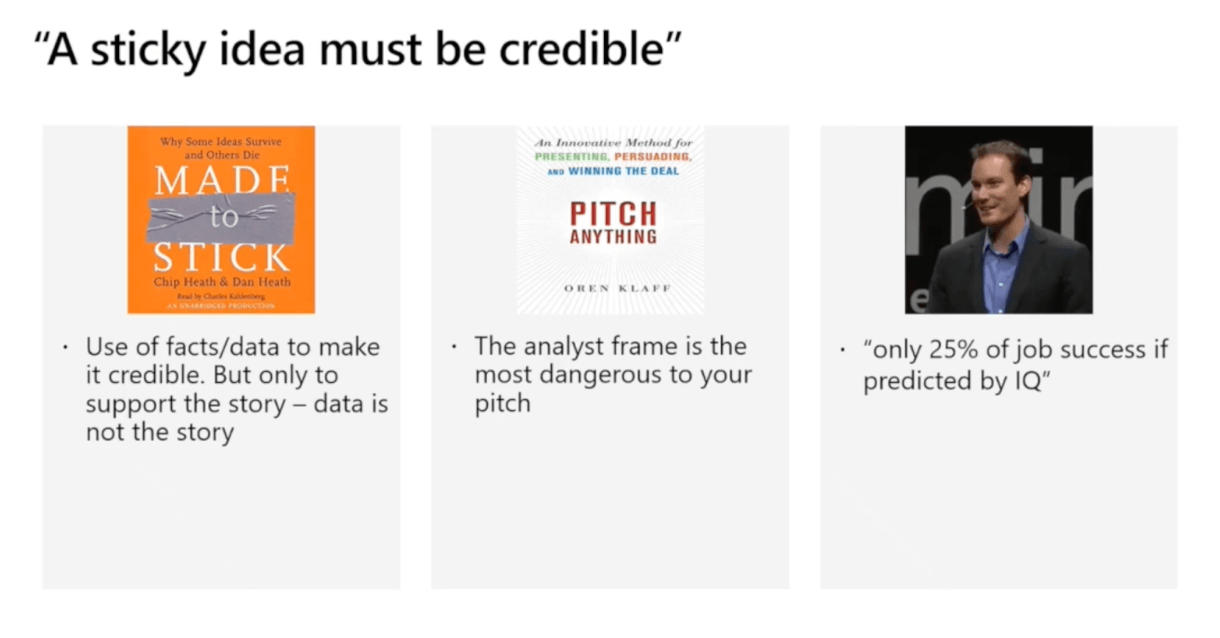
We all know we need to use proof points to make our arguments credible, but people often overdo it.
The more stats you use, the more you dilute their value. Instead, focus on the point that is most connected to your armature. Your numbers are there to support the point you're making, not to be the star of the show. Shawn does this really well by only highlighting the stats that are most important for his talk.
Using the power frame
As well as sharing statistics to back up his argument, Shawn shows a slide with some scientific papers that support his point.
Like Shawn, when you use proof points to make your story credible, you can also cite research papers and borrow their credibility. This is called the power frame, and the power frame comes from authority.
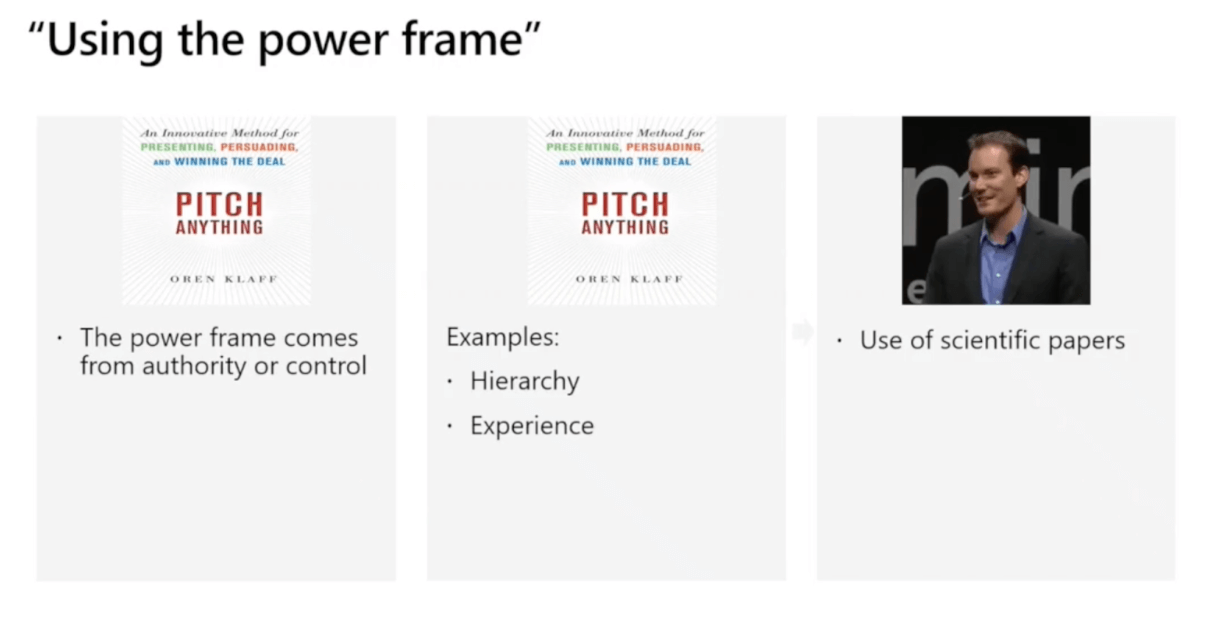
In my job, when I’m struggling to get a consensus on a pitch deck, the power frame that I like to use the most is the endorsement of clients. When we show that we’ve tested a narrative with important clients and the message resonates, that's usually a very compelling argument in a customer-focused organization.
Closing your narrative
Now, let’s get to the third act of your narrative: the closing. We all like to give clear calls to action when we close our stories. You just need to make sure that the call to action is presented from the audience's perspective, not your own.
It's less about “go do this” and more about what you can get if you do this. The more personal you make this to the audience, the better.
A great example comes from a campaign to prevent littering in Texas. It says, “Don't mess with Texas.” The message here is that if you love Texas, you won’t litter because what you love is at stake.
Shawn does a great job of this too. Let's see how he closes his TED Talk:
We’ve found that there are ways you can train your brain to be able to become more positive. In just a two-minute span of time, done for 21 days in a row, we can actually rewire your brain, allowing your brain to actually work more optimistically and more successfully.
He makes the benefit for the audience very clear: we live in a crazy world, but if you do what I tell you, you will adapt and respond to any circumstance or headwinds that life throws at you.
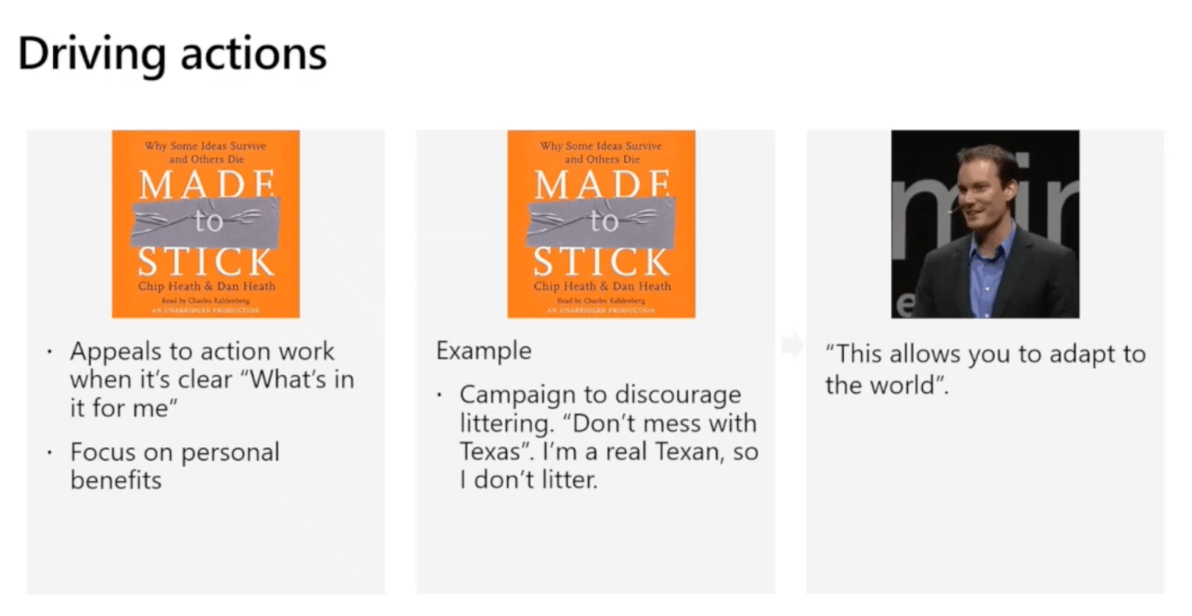
Sticky ideas are concrete and descriptive
The less abstract and the more concrete you can be in your call to action, the better. Imagine you have a request for your customer support organization. Instead of saying, “We need to deliver exceptional customer care to our clients,” maybe you can try, “Let's accept returns, even if the product is not damaged.”
Similarly, in this TED Talk, the speaker is very clear about the practical things that people can do every day to create a lasting positive change. Take a look.
We've done these things in research now in every company that I've worked with:
Getting them to write down three new things that they're grateful for 21 days in a row – three new things each day – and at the end of that, their brain starts to retain a pattern of scanning the world not for the negative, but for the positive first.
Journaling about one positive experience you've had over the past 24 hours allows your brain to relive it.
Exercise teaches your brain that your behavior matters.
We find that meditation allows your brain to get over the cultural ADHD that we've been creating by trying to do multiple tasks at once and allows our brains to focus on the task at hand.
And finally, random acts of kindness or conscious acts of kindness – we get people, when they open up their inbox, to write one positive email praising or thanking somebody in their support network.
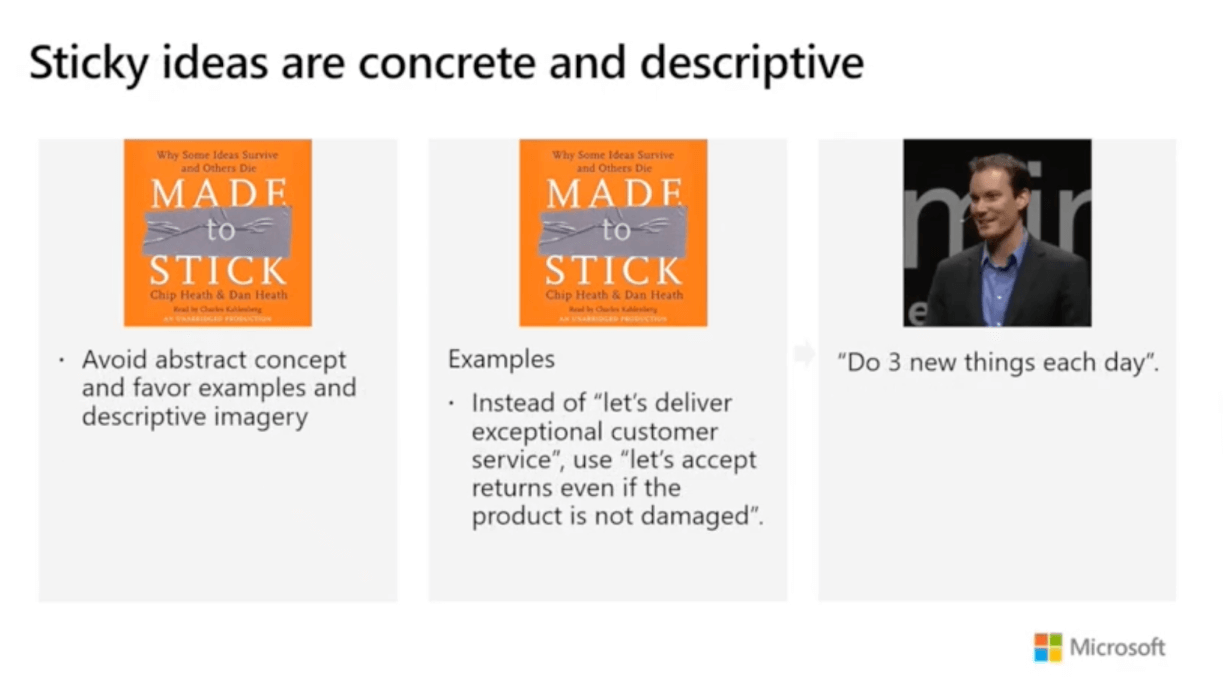
Closing thoughts
Thank you so much for checking out this case study. I hope it was useful. I want to close by reinforcing that all these techniques take practice and will only work well when you have a deep knowledge of your audience and their worldview.
This'll allow you to frame your stories in a way that creates an emotional connection. It takes a long time and a lot of work, but it’s worth it.
Finally, I want to share something that I learned from my dear storytelling and life mentor, Percival Caropreso. He taught me that ”Our responsibility is the size of our privilege.”
We reach and influence so many people with our stories, so make sure that they’re inclusive and that they lead to actions that make the world a better place.


















 Follow us on LinkedIn
Follow us on LinkedIn



.svg?v=7919bee89c)